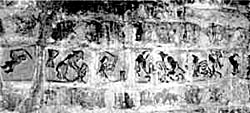< Previous | Contents | Next >
Calverton church
 |
CALVERTON CHURCH is dedicated to the great missionary bishop, St. Wilfred, who died in 709, and to whom both Northumbria and Sussex owe so much of their Christianity and civilisation. A queer figure of him, wrought in the early 12th century—about the time that Peveril established Lenton Priory—can be seen on the capital at the north side of the chancel arch.
But Calverton Church is not a very thrilling place on the whole, for the ancient church was destroyed and the present church built about 1760, a time which produced substantial, but rather dull architecture.
If, however, the visitor be so fortunate as to obtain access to the belfry, he will find, built into the wall for preservation, a series of carvings which gives a delightfully naive representation of the daily life of our forefathers, for they are part of a farmer’s calendar which must have enriched an archway in the ancient church.
January is represented by a man seated at a table laden with good cheer, including a boar’s head. February, a man crouching over a fire, and note how he warms the sole of his foot. April, a figure prunes a tree or vine with a large knife. June, he is hoeing with a mysterious implement amongst growing crops. In August he mowed corn with a sickle and wears a huge brimmed hat. September is represented by two stones whereon men are depicted thrashing with flails.
There are two other stones which do not fit into the calendar at all. On one a man rides a horse and carries a hawk on his wrist, and in the lower compartment is a weird dog—rather like a greyhound with a tufted tail! And on the final stone, which is outside the tower near the ground on the north side, two figures seem to be dancing a Morris dance.
A similar series of figures to these may be seen at Burnham Deepdale, in Norfolk, and at Brooklands, in Kent.
